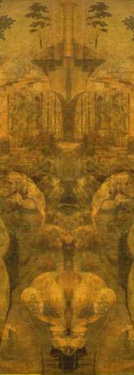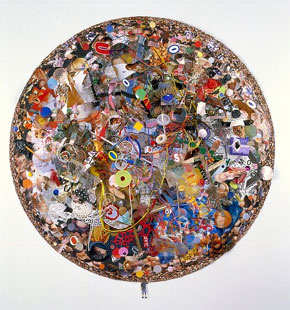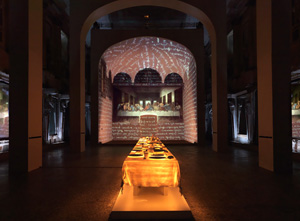Leonardo's Broken Symmetry
John Haberin New York City
Globalization, New Media, and The Last Supper
The New York Times Magazine has discovered great art. It is also finding the past in pixels—and the more, the better.
Perhaps the real-estate section still shouts, "location, location, location." But what if art's location is everywhere and nowhere? Not unreasonably, the Sunday Times finds a double threat to the art object, in new media and the global marketplace. In fact, it finds them as two of a kind. Far from undermining high prices and the aura of the work of art, high-tech reproductions are moving sales. 
One writer sees mere jpegs as the ticket to marketing hot artists, in the global age celebrated by Tom Friedman. Meanwhile, yet another computer experiment, this time with Photoshop, finds the real da Vinci code.
Forget high resolution
The Sunday paper has boasted before that pixels change everything. For another Times writer, a Web site presents The Last Supper at least as vividly as in Milan, while flat panels are replacing the display of valued works. It should say something how often these claims revert to Leonardo. In each case, science and technology have assimilated the authority of the artistic genius.
However, have they seen through the work of art, or have they just replaced one myth with another? To see how easily the mainstream absorbs technology and exploits a kind of guerilla marketing, take this quote from the Arts & Leisure pages:
In Los Angeles, Timothy Blum of Blum & Poe said he sold a "handful" of works by the conceptual artist Dave Muller, sight unseen, from his January show, at prices up to $100,000.
Well, that makes him a conceptual artist, right? He definitely knows the price of everything and the value of nothing.
In fact, the article concerns the rising power of jpegs to drive sales. Perhaps conceptual art rarely finds more than a handful buyers anyway. Either way, says The Times, shows can all but sell out based on little more than an artist's reputation, good salesmanship, and those cleverly compressed images that sacrifice pixels for ease of electronic transmission.
In this way, technology enables a privileged connection between client and customer. With the malling of Chelsea and busy art fairs competing with the Armory Show and with a critic as curator, a collector may demand to rise above the crowds. The jpegs reside at a password-protected Web address or arrive by email, marking the viewers as exclusive customers.
I enjoyed still another chance to lament the shallow priorities of collectors. They let jpegs drive reputations, much as mass marketing can make a product logo indispensable. I could also happily excuse a reliance on jpegs on the grounds that the buyers will know an artist quite well, thank you, from past work. Perhaps philosophers will excuse it instead on the grounds that all art has become conceptual. If Arthur C. Danto finds Andy Warhol's Brillo indiscernible from the real thing, no doubt buyers can find art indiscernible from its reproduction as well.
Regardless, a focus on jpegs misses the bigger story—the growing power of markets to shape judgment. One can see it in the article's examples, with staggering prices for unfamiliar names: as with fashion, the hottest brand names can swiftly rise and fall. These reputations turn on work easy to grasp and quick to sell. The article mentions John Sonsini's portraits of Mexican-American laborers, at a gallery known best for important artists with aging reputations. Sonsini combines subject matter sure to appease the conscience of collectors with a familiar, slapdash style, halfway between Sunday painting and Alice Neel.
The art is flat
One could argue that little has changed. The article sticks to a handful of dealers with unusual clout. Besides, dealers and art-history lectures have long demanded slides, and artists have long had strong sales in advance of an opening long before the digital age. If jpegs now allow buyers not just a shot at a scarce commodity, but a choice of color, too, more power to them. However, all that only underscores how much has changed—starting with the growing authority accorded the taste of successful artists, dealers, and collectors.
Something else has changed, too, as these markets become not just more efficient, inclusive, and exclusive, but also global. Indeed, academic programs are extending their reach as well, to the point of making careers as fast as the Ethernet. The jpegs circulate because buyers or artists do not necessarily live in New York City. I myself bought from an artist, Christina McPhee, without being able to travel to LA for her show. When I received the paintings, I loved them even more than I expected. I just regret my timing, since her art has really taken flight with a New York dealer and digital landscapes.
That Times article's lead example, Tom Friedman, was having his first show in Beverly Hills. I felt like an insider when I caught it myself on a rare trip to LA, and I remember most an Italian meal just down the street. (It was not the Last Supper.) Not coincidentally, those soothing, colorful, undistinguished tondos amount to both assemblages of consumer goods and pretend maps of the planet. Maybe, as his gallery promises, his work amounts to a "phenomenological discourse about art and life," or maybe it just serves as a marketing campaign for globalization and suburbia in the Third World. If, as another Tom Friedman says, the world is flat, why not hang it on a gallery wall?
 With or without pixels, then, commercial channels only continue to grow in number, size, and power. They quickly absorb new media along with the old—perhaps even more quickly, for status and celebrity depend on the new. One may not like the results, just as tabbed browsing in Internet Explorer looks so clumsy and comes so many years after Mozilla. Besides, when artists talk only to one another, as in Internet forums, something in the vitality and definition of art again changes, perhaps for the worse.
With or without pixels, then, commercial channels only continue to grow in number, size, and power. They quickly absorb new media along with the old—perhaps even more quickly, for status and celebrity depend on the new. One may not like the results, just as tabbed browsing in Internet Explorer looks so clumsy and comes so many years after Mozilla. Besides, when artists talk only to one another, as in Internet forums, something in the vitality and definition of art again changes, perhaps for the worse.
This means some pretty substantial revision of a persistent theme in both Modernism and Postmodernism. I mean the idea that reproducible media had put a stake through the heart of the "originality of the avant-garde." Once Rosalind E. Krauss, like Walter Benjamin before her, hoped that reproducible art forms would undermine the allure of authenticity. Instead, the aura of science can now collude with the aura of the work of art. And both can now have international reach.
The mystique of technology extends still further as well. It can purport to determine how artists work and what they mean. As often as not, too, it is this claim rather than the art that needs explaining away. My related reviews have looked at art and science as visions of nature and humanity, science and Postmodernism, the materials and methods of art, and how digital art can lie. Recently, too, a geek has headed right back to The Last Supper after all.
The da Vinci coed
In his notebooks, Leonardo typically wrote from right to left. His flowing Italian cursive looks even more intriguing once one can no longer read it. It does not exactly hide his meaning. Still, it goes to show that, as in particle physics, symmetry breaking can locate designs in nature better even than perfection. In fact, that mantra could almost sum up the High Renaissance style.
Slavisa Pesci must not have been paying attention. The Italian, a self-styled amateur scholar and "information technologist," got some midsummer 2007 headlines by imposing symmetry on Leonardo. (Now that mockery has had a chance to die down, a group calling itself the Mirror of the Sacred Scriptures and Paintings World Foundation is trying to revive the claim in time for Christmas.) Apparently information technology really is not all that far from information overload.
Layering a mirror image of The Last Supper onto the original, Pesci claims to have discovered long-secret images. Jesus, it seems, presides over a wine goblet. An apostle or two sports the robe of a knight, and another morphs into a woman cradling a child. While an offer of wine at the Last Supper does not sound terribly shocking, it still briefly lured enough fans of The da Vinci Code to crash a few Web sites.
I almost missed the story entirely, perhaps a hopeful sign that last year's fad is passing. It sounds silly because it is. The "goblet" arises from forced reflections of Jesus's robe, as innocent as the jewels in a child's kaleidoscope. The "knights" do not bear arms, the pattern on their robe looks no more than random, and one has to readjust the image alignment for quite some time to get even a semblance of it. Misshapen folds have to pass for the "child," and the familiar soft features of a young man have to do for the "woman." Instead of Mary Magdalene, one will just have to settle for the da Vinci coed.
These things make sense only if one finds wine at the Last Supper too shocking to reveal. They make sense only if one can imagine a way for Leonardo to construct the imagery in oil rather than Photoshop, especially without the slightest hint of such experiments in his gargantuan notebooks or in recollections by others of his titanic intellect. They make sense only one believes he cared more about all this than about visible works that have entered the heart of Western culture. They make sense, too, only if one tunes out common sense about symmetry. Not to be outdone, Pesci's experiments sent me into Photoshop myself, after surfing the Web. Once one gets the hang of it, the game becomes downright addictive.
In the interest of objectivity I tried to balance old favorites and chance discoveries. The author photo in that day's Times book review gains a necklace, a mysterious tattoo, and a newfound hauteur. The woman in The Haymakers by George Stubbs becomes a four-armed Hindu goddess, and a dark mandorla forms in the tree above her head. The glorious Ingres portrait in the Frick acquires a broad third eye in her forehead and a pig's snout. Backs turn into stately dresses, profiles gain full faces, and the shepherd in La Primavera by Sandro Botticelli becomes a devil, with long hair over an ass in place of a head.
Symmetry and chance
The exercise confirms what, I trust, you already know. With too much time on one's hands, one can create mounds of selective evidence. With enough imagination, one can read anything into anything. South Asian art uses more patterning and symmetry than the Italian Renaissance—and, hieratic and fanciful as it is, found inspiration in the visible world. Cubism was superfluous. 
Well, obviously not the last, but there may yet be a lesson about Leonardo after all. He can again become not a subversive trickster, but the imaginative model for his age and for generations to come. Not just symmetry, but also its violation, does give the High Renaissance much of its distinction. The period coped with the tensions of early Renaissance ideals amid new political pressures. It also explored as never before the tension between the viewer's perspective and a view of eternity.
Leonardo did much to create the art of his time, and his steady awareness of broad design even in his most fluid curves does much to make his forms and psychology so lifelike. No wonder the apostles leaning toward Jesus in The Last Supper fit so perfectly into the gap between him and his betrayer on the other side. As it happens, a reader of mine named Bill Mackie has been playing around with The Adoration of the Magi (seen at the top of this review) and other images of Leonardo's, and I hope he gets to publish them one day. (He has the equally odd explanation that Leonardo felt the influence of Asian art, which had not reached Italy, but found this so subversive he had to hide it, as if the inquisition had come for Marco Polo.) If a mind like Leonardo's had had access to a computer—or a sophisticated enough array of mirrors, lenses, and a light source—he would have had a field day.
That need not mean touting instead the ineffable qualities of art, not when art has to compete with such fancy gadgets (and Urs Fischer has indeed filled the The Last Supper pizza and other terrors). It should, though, keep one guessing. Tired of the originality of the avant-garde on the one hand and commodification on the other? Try instead to appreciate the work of art within a skeptical, critical perspective.
As fans of Star Wars know, technology and the market alike have enormous appeal but also a dark side. I may not see the world as so starkly in terms of good and evil, but artists, too, are making the most of new media and the marketplace. Money does, as Jerry Saltz argues, risk making people stupid and making stupid art. Awe and fear at the authority of science have a way of doing the same. Who can resist explaining away Rembrandt—especially if his prices can still rise? Maybe it is time one stopped equating explaining art with either selling it or explaining it away.
Leonardo deserves the last word, but this time alongside another seeker of hidden significance. To quote Freud, "If one considers chance to be unworthy of determining our fate, it is simply a relapse into the pious view of the Universe that Leonardo himself was on the way to overcoming." The artist sounds more prescient this time than ever—not of Impressionism, but of entropy, earthworks, and installations. Now if only Leonardo could shock the public for something other than high prices, coded messages, and peeling paint.

Tom Friedman ran at Gagosian in Los Angeles through December 9, 2006. I quote The New York Times for February 4, 2007, on Timothy Blum.




